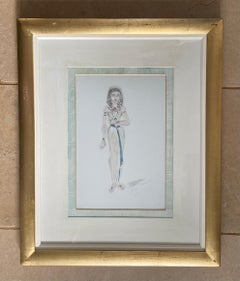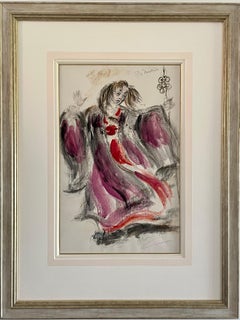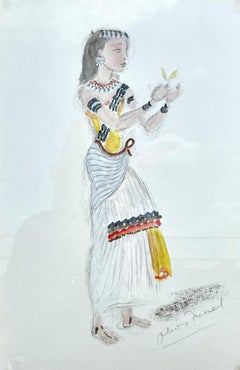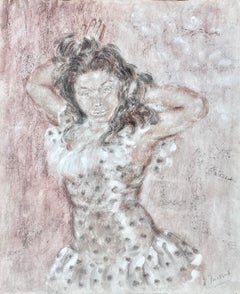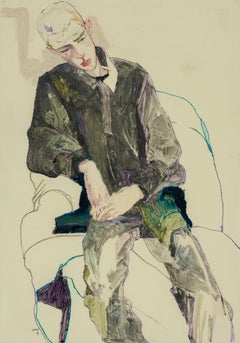Oliver Messel Figurative Drawings and Watercolors
British, 1904-1978
Born in London, his mother being the daughter of the Punch cartoonist Edward Linley Sambourne and his father a soldier and stockbroker. After Eton he studied art at the Slade under Henry Tonks; Rex Whistler was a fellow student. Although his studies concentrated on life drawings he also made papier mache and wax masks for student events and an exhibition of these masks at the Claridge Galleries in 1925 let to his first theatre design commission for the Diaghilev ballet production of Zeephyre et Flore. By the early 1930s had established himself as one of Britain’s principal designers for the stage. He went on to design for many theatrical, operatic, ballet and film productions becoming one of the most highly paid and sought after theatre designers in the world.
His books included Stage Designs and Costumes, 1933; Designs for A Midsummer Night’s Dream, 1957 and Delightful Food, 1958. He held one-man exhibitions at the Leicester Galleries and Redfern Gallery, designed interiors and gardens of the Dorchester Hotel, Flaxley Abbey, Gloucestershire and elsewhere as well as several houses and grounds in Barbados and Mustique. The Victoria & Albert Museum hold the majority of his design archives.(Biography provided by Sarah Colegrave Fine Art)
to
6
4
6
5
1
Overall Height
to
Overall Width
to
6
6
4
2
2
2
1
1
1
6
1
7
671
326
198
131
6
6
1
Artist: Oliver Messel
Oliver Messel - Costume Design for Vivian Leigh in Caesar and Cleopatra - 1945
By Oliver Messel
Located in London, GB
OLIVER MESSEL
(1904-1978)
Blue Costume Design for Vivian Leigh in Caesar and Cleopatra - 1945
Signed l.r.: Oliver Messel
Watercolour and chalks heightened with white and gold pain...
Category
Mid-20th Century Realist Oliver Messel Figurative Drawings and Watercolors
Materials
Watercolor
Rashomon - A 1950 costume design for the New York Theatre by Oliver Messel
By Oliver Messel
Located in London, GB
OLIVER MESSEL
(1904-1978)
The Medium – Costume Design for Peter Glenville’s Rashomon, Performed at the Music Box, New York, 1959
Signed l.r.: Oliver Messel and inscribed u.r.: The...
Category
Mid-20th Century Realist Oliver Messel Figurative Drawings and Watercolors
Materials
Watercolor
Oliver Messel - Costume Design for Caesar and Cleopatra, 1945
By Oliver Messel
Located in London, GB
OLIVER MESSEL
(1904-1978)
Egyptian Costume Design for Caesar and Cleopatra - 1945
Signed l.r.: Oliver Messel
Watercolour and chalks heightened ...
Category
Mid-20th Century Realist Oliver Messel Figurative Drawings and Watercolors
Materials
Watercolor
Oliver Messel - Costume Design for Vivien Leigh in Caesar and Cleopatra
By Oliver Messel
Located in London, GB
OLIVER MESSEL
(1904-1978)
Blue Costume Design for Caesar and Cleopatra - 1945
Signed l.r.: Oliver Messel
Watercolour and chalks heightened with...
Category
Mid-20th Century Oliver Messel Figurative Drawings and Watercolors
Materials
Watercolor
The Dancer - 20th Century British painting by Oliver Messel
By Oliver Messel
Located in London, GB
OLIVER MESSEL
(1904-1978)
Dancer
Signed l.r.: Oliver Messel
Oil and watercolour on paper
Framed
60 by 50 in., 23 ½ by 19 ¾ cm.
(Frame size 76.5 by 66.5 in., 30 by 26 ¼ cm.)
Bor...
Category
Mid-20th Century Realist Oliver Messel Figurative Drawings and Watercolors
Materials
Oil, Watercolor
Opera Costume Design for The Barber of Seville by Oliver Messel
By Oliver Messel
Located in London, GB
OLIVER MESSEL
(1904-1978)
Costume Design for Rosina in the Barber of Seville
Signed and indistinctly inscribed
Watercolour and bodycolour, framed
...
Category
1950s Realist Oliver Messel Figurative Drawings and Watercolors
Materials
Watercolor
Related Items
The Abduction of the Sabine Women , a Renaissance drawing by Biagio Pupini
Located in PARIS, FR
This vigorous drawing has long been attributed to Polidoro da Caravaggio: The Abduction of the Sabine Women is one of the scenes that Polidoro depicted between 1525 and 1527 on the façade of the Milesi Palazzo in Rome. However, the proximity to another drawing inspired by this same façade, kept at the Ecole des Beaux-Arts, and to other drawings inspired by Polidoro kept at the Musée du Louvre, leads us to propose an attribution to Biagio Pupini, a Bolognese artist whose life remains barely known, despite the abundant number of drawings attributed to him.
1. Biagio Pupini, a Bolognese artist in the light of the Roman Renaissance
The early life of Biagio Pupini, an important figure of the first half of the Cinquecento in Bologna - Vasari mentions him several times - is still poorly known. Neither his date of birth (probably around 1490-1495) nor his training are known. He is said to have been a pupil of Francesco Francia (1450 - 1517) and his name appears for the first time in 1511 in a contract with the painter Bagnacavallo (c. 1484 - 1542) for the frescoes of a church in Faenza. He then collaborated with Girolamo da Carpi, at San Michele in Bosco and at the villa of Belriguardo.
He must have gone to Rome for the first time with Bagnacavallo between 1511 and 1519. There he discovered the art of Raphael, with whom he might have worked, and that of Polidoro da Caravaggio. This first visit, and those that followed, were the occasion for an intense study of ancient and modern art, as illustrated by his abundant graphic production.
Polidoro da Caravaggio had a particular influence on the technique adopted by Pupini. Executed on coloured paper, his drawings generally combine pen, brown ink and wash with abundant highlights of white gouache, as in the drawing presented here.
2. The Abduction of the Sabine Women
Our drawing is an adaptation of a fresco painted between 1525 and 1527 by Polidoro da Caravaggio on the façade of the Milesi Palace in Rome. These painted façades were very famous from the moment they were painted and inspired many artists during their stay in Rome. These frescoes are now very deteriorated and difficult to see, as the palace is in a rather narrow street.
The episode of the abduction of the Sabine women (which appears in the centre of the photo above) is a historical theme that goes back to the origins of Rome and is recounted both by Titus Livius (Ab Urbe condita I,13), by Ovid (Fasti III, 199-228) and by Plutarch (II, Romulus 14-19). After killing his twin brother Romus, Romulus populates the city of Rome by opening it up to refugees and brigands and finds himself with an excess of men. Because of their reputation, none of the inhabitants of the neighbouring cities want to give them their daughters in marriage. The Romans then decide to invite their Sabine neighbours to a great feast during which they slaughter the Sabines and kidnap their daughters.
The engraving made by Giovanni Battista Gallestruzzi (1618 - 1677) around 1656-1658 gives us a good understanding of the Polidoro fresco, allowing us to see how Biagio Pupini reworked the scene to extract this dynamic group.
With a remarkable economy of means, Biagio Pupini takes over the left-hand side of the fresco and depicts in a very dense space two main groups, each consisting of a Roman and a Sabine, completed by a group of three soldiers in the background (which seems to differ quite significantly from Polidoro's composition).
The balance of the drawing is based on a very strongly structured composition. The drawing is organised around a median vertical axis, which runs along both the elbow of the kidnapped Sabine on the left and the foot of her captor, and the two main diagonals, reinforced by four secondary diagonals. This diamond-shaped structure creates an extremely dynamic space, in which centripetal movements (the legs of the Sabine on the right, the arm of the soldier on the back at the top right) and centrifugal movements (the arm of the kidnapper on the left and the legs of the Sabine he is carrying away, the arm of the Sabine on the right) oppose each other, giving the drawing the appearance of a whirlpool around a central point of support situated slightly to the left of the navel of the kidnapper on the right.
3. Polidoro da Caravaggio, and the decorations of Roman palaces
Polidoro da Caravaggio was a paradoxical artist who entered Raphael's (1483 - 1520) workshop at a very young age, when he oversaw the Lodges in the Vatican. Most of his Roman work, which was the peak of his career, has disappeared, as he specialised in facade painting, and yet these paintings, which are eminently visible in urban spaces, have influenced generations of artists who copied them abundantly during their visits to Rome.
Polidoro Caldara was born in Caravaggio around 1495-1500 (the birthplace of Michelangelo Merisi, known as Caravaggio, who was born there in 1571), some forty kilometres east of Milan. According to Vasari, he arrived as a mason on the Vatican's construction site and joined Raphael's workshop around 1517 (at the age of eighteen according to Vasari). This integration would have allowed Polidoro to work not only on the frescoes of the Lodges, but also on some of the frescoes of the Chambers, as well as on the flat of Cardinal Bibiena in the Vatican.
After Raphael's death in 1520, Polidoro worked first with Perin del Vaga before joining forces with Maturino of Florence (1490 - 1528), whom he had also known in Raphael's workshop. Together they specialised in the painting of palace façades. They were to produce some forty façades decorated with grisaille paintings imitating antique bas-reliefs.
The Sack of Rome in 1527, during which his friend Maturino was killed, led Polidoro to flee first to Naples (where he had already stayed in 1523), then to Messina. It was while he was preparing his return to the peninsula that he was murdered by one of his assistants, Tonno Calabrese, in 1543.
In his Vite, Vasari celebrated Polidoro as the greatest façade decorator of his time, noting that "there is no flat, palace, garden or villa in Rome that does not contain a work by Polidoro". Polidoro's facade decorations, most of which have disappeared as they were displayed in the open air, constitute the most important lost chapter of Roman art of the Cinquecento. The few surviving drawings of the painter can, however, give an idea of the original appearance of his murals and show that he was an artist of remarkable and highly original genius.
4. The façade of the Milesi Palace
Giovanni Antonio Milesi, who commissioned this palace, located not far from the Tiber, north of Piazza Navona, was a native of the Bergamo area, like Polidoro, with whom he maintained close friendly ties. Executed in the last years before the Sack of Rome, around 1526-1527, the decoration of Palazzo Milesi is considered Polidoro's greatest decorative success.
An engraving by Ernesto Maccari made at the end of the nineteenth century allows us to understand the general balance of this façade, which was still well preserved at the time. The frescoes were not entirely monochrome, but alternated elements in chiaroscuro simulating marble bas-reliefs and those in ochre simulating bronze and gold vases...
Category
16th Century Old Masters Oliver Messel Figurative Drawings and Watercolors
Materials
Ink, Gouache, Pen
Lee Hurst (3/4 Figure, Hands Together), Mixed media on Pergamenata parchment
By Howard Tangye
Located in London, GB
Howard Tangye (b.1948, Australia) has been an influential force in fashion for decades. Lecturing at London’s Central Saint Martins for 35 years, including 16 years as head of BA Wom...
Category
2010s Contemporary Oliver Messel Figurative Drawings and Watercolors
Materials
Paint, Paper, Parchment Paper, Charcoal, Crayon, Oil Crayon, Oil Pastel,...
Porsche. Figurative realistic acrylic on paper painting Polish art, Car
By Michal Wojtysiak
Located in Warsaw, PL
Acrylic on paper contemporary figurative painting by Michal Wojtysiak. Artwork depicts Porsche 993 Turbo car in realistic style. The color is vibrant and saturated. Michal Wojtysiak...
Category
2010s Realist Oliver Messel Figurative Drawings and Watercolors
Materials
Paper, Acrylic
Freya (Seated Backwards), Mixed media on grey board
By Howard Tangye
Located in London, GB
Howard Tangye (b.1948, Australia) has been an influential force in fashion for decades. Lecturing at London’s Central Saint Martins for 35 years, including 16 years as head of BA Wom...
Category
2010s Contemporary Oliver Messel Figurative Drawings and Watercolors
Materials
Other Medium, Archival Paper, Handmade Paper, Pen, Felt Pen, Permanent M...
The Flower Seller - French Realist Figurative Watercolor by Victor Gilbert
By Victor Gabriel Gilbert
Located in Marlow, Buckinghamshire
Signed figurative watercolour on board by French realist painter Victor Gabriel Gilbert. The work depicts a flower seller at her market stall selling beautifully coloured bouquets of...
Category
Early 1900s Realist Oliver Messel Figurative Drawings and Watercolors
Materials
Board, Watercolor
The Prince's Room
By Willy Pogany
Located in Buffalo, NY
Born in Szeged, Hungary, he became one of the better known and successful illustrators of the Golden Age of Illustration, completing over 100 books. Among them are "A Treasury of Verse for Little Children," "The Rubaiyat of Omar Khayyam," and "The Rime of the Ancient Mariner." He is probably best known for pen and ink drawings of mythology subjects geared towards children.
He studied at Budapest Technical University and attended art schools in Munich and Paris before moving to London at age 23. In 1907, he began illustrating children's books and did a series of annual gift books...
Category
1940s Realist Oliver Messel Figurative Drawings and Watercolors
Materials
Gouache, Graphite, Pen, Watercolor
"Study for decoration Moscow metro station" Kievskaya Tempera, Real socialism
Located in Torino, IT
Real Socialism,Moscow,1970,Russia,Orange,Men at Work,Propaganda
VIKTOR A. KONOVALOV (Uidol, Vladimir region 1912 – Moscow 1995)
Russian painter and gr...
Category
1950s Realist Oliver Messel Figurative Drawings and Watercolors
Materials
Paper, Tempera
Citroen 15CV - Contemporary Watercolor & Ink Painting, Vintage Car, Realistic
By Mariusz Szałajdewicz
Located in Warsaw, PL
Mariusz Szalajdewicz (b. 1974)
Studied at the Faculty of Architecture at Warsaw University of Technology, where he mastered the drawing skill. Architect and urbanist, illustrator.
Category
21st Century and Contemporary Realist Oliver Messel Figurative Drawings and Watercolors
Materials
Paper, Ink, Watercolor
Mercedes 300 SLR Uhlenhaut coupe Figurative acrylic on paper painting Polish art
By Michal Wojtysiak
Located in Warsaw, PL
Acrylic on paper contemporary figurative painting by Michal Wojtysiak. Artwork depicts mercedes car in realistic style.
MICHAŁ WOJTYSIAK (ur. 1984)
Graduated of Academy of Fine Art...
Category
2010s Realist Oliver Messel Figurative Drawings and Watercolors
Materials
Paper, Acrylic
Porsche. Figurative realistic acrylic on paper painting Polish art, Car
By Michal Wojtysiak
Located in Warsaw, PL
Acrylic on paper contemporary figurative painting by Michal Wojtysiak. Artwork depicts Porsche 911 Targa 4s car in realistic style. The color is vibrant and saturated. Michal Wojtys...
Category
2010s Realist Oliver Messel Figurative Drawings and Watercolors
Materials
Paper, Acrylic
Gustave Fraipont (1849-1923) A peasant girl with her flock of Turkeys, drawing
By Gustave Fraipont
Located in Paris, FR
Gustave Fraipont (1849-1923)
A Peasant girl with her flock of Turkeys,
Ink and heightenings of blue watercolor on paper
23 x 15 cm
Signed on the lower left and titled on lower righ...
Category
1890s Realist Oliver Messel Figurative Drawings and Watercolors
Materials
India Ink, Watercolor
Glamour. Fashion Illustration Figurative Watercolor Geclee Print
By Oksana Tanasiv
Located in Norwalk, CT
Limited Edition Geclee Print 1 of 50 Edition, on Watercolor Paper , hand-embellished by watercolor.
The size of geclee print is 11"X14" . Size with the white matt is 20″X16″.
Framed...
Category
2010s Realist Oliver Messel Figurative Drawings and Watercolors
Materials
Watercolor
H 14 in W 11 in D 0.2 in
Oliver Messel figurative drawings and watercolors for sale on 1stDibs.
Find a wide variety of authentic Oliver Messel figurative drawings and watercolors available for sale on 1stDibs. You can also browse by medium to find art by Oliver Messel in paint, watercolor, oil paint and more. Not every interior allows for large Oliver Messel figurative drawings and watercolors, so small editions measuring 10 inches across are available. Customers who are interested in this artist might also find the work of John Gould, Cecil Beaton, and Raphael Soyer. Oliver Messel figurative drawings and watercolors prices can differ depending upon medium, time period and other attributes. On 1stDibs, the price for these items starts at $1,734 and tops out at $3,185, while the average work can sell for $1,911.
